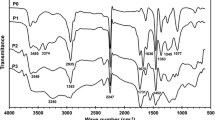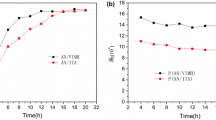Abstract
Polyacrylonitrile copolymers with different molecular weights (Mws) are synthesised by aqueous free-radical redox polymerisation technique. Polyacrylonitrile (PAN) and lignin-blended solutions are prepared in dimethyl sulphoxide solvent by varying the polyacrylonitrile/lignin content. The effect of lignin addition to PAN copolymer having different weight-average Mws on the rheological properties is explored. Rheological measurements indicate that the solution viscosity reduces with the increase in the lignin content. The Cole–Cole plot or Han plot and Casson plot are used to characterise the solution homogeneity. The slope value of the plot suggests that the molecular-level homogeneity of the solution is not affected much by the addition of lignin. Thermal-induced gelation of concentrated solution has been rheologically investigated to avoid overheating of solution during the dissolution, storage and transportation for further wet spinning process.









Similar content being viewed by others
References
Paul JW (2000) Carbon fibers vol 21. ASM Handbook, pp 35–39
Morgan P (2005) Carbon fibers and their composites. Taylor and Francis group, NW Boca Raton
James CM (1995) Acrylic fibre technology and applications. Marcel Dekker Inc, New York
Chen H, Pan Y, Hou S, Shao Z, Hong Y, Ju A (2017) Poly (acrylonitrile-co-2-methylenesuccinamic acid) as a potential carbon fiber precursor: preparation and stabilization. RSC Adv 7:54142–54152
Hanna SB, Yehia AA, Ismail MN, Khalaf AI (2012) Preparation and characterization of carbon fibers from polyacrylonitrile precursors. J Appl Polym Sci 123:2074–2083
Shin HK, Park M, Kang PH, Choi H-S, Park S-J (2014) Preparation and characterization of polyacrylonitrile-based carbon fibers produced by electron beam irradiation pretreatment. J Ind Eng Chem 20:3789–3792
Tian D, Chandra RP, Lee J-S, Canhui L, Saddler JN (2017) A comparison of various lignin-extraction methods to enhance the accessibility and ease of enzymatic hydrolysis of the cellulosic component of steam-pretreated poplar. Biotechnol Biofuels 10(1):157
Zhu W, Theliander H (2015) Precipitation of lignin from softwood black liquor: an investigation of the equilibrium and molecular properties of lignin. BioResources 10(1):1696–1714
Luo J, Genco J, Cole B, Fort R (2011) Lignin recovered from the near-neutral hemicellulose extraction process as a precursor for carbon fiber. BioResources 6(4):4566–4593
Hosseinaei O, Harper DP, Bozell JJ, Rials TG (2017) Improving processing and performance of pure lignin carbon fibers through hardwood and herbaceous lignin blends. Int J Mol Sci 18(7):1410
Kubo S, Kadla JF (2005) Kraft lignin/poly (ethylene oxide) blends: effect of lignin structure on miscibility and hydrogen bonding. J Appl Polym Sci 98:1437–1444
Liu HC, Chien AT, Newcomb BA, Liu Y, Kumar S (2015) Processing, structure, and properties of lignin-and CNT-incorporated polyacrylonitrile-based carbon fibers. ACS Sustain Chem Eng 3:1943–1954
Jin J, Ogale AA (2018) Carbon fibers derived from wet‐spinning of equi‐component lignin/polyacrylonitrile blends. J Appl Polym Sci 135(8):45903
Sazanov Y, Krutov S, Ipatova Y, Kosyakov D, Kulikova Y (2017) Mechanism of interaction between hydrolytic lignin and Poly (acrylonitrile). Eurasian Chem Technol J 19:23–29
Özgür Seydibeyoğlu M (2012) A novel partially biobased PAN-lignin blend as a potential carbon fibre precursor. J Biomed Biotechnol. https://doi.org/10.1155/2012/598324
Dong X, Chunxiang L, Zhou P, Zhang S, Wang L, Li D (2015) Polyacrylonitrile/lignin sulfonate blend fiber for low-cost carbon fiber. RSC Adv 5:42259–42265
Lianjiang T, Ajun W, Ding P (2011) Viscoelasticity of concentrated polyacrylonitrile solutions: effects of solution composition and temperature. Polym Int 60:1047–1052
Weiping D, Huifang C, Haifeng X, Ning P, Ding P (2009) Viscoelastic behavior of polyacrylonitrile/dimethyl sulfoxide concentrated solution with water. J Polym Sci B Polym Phys 47:1437–1442
Brunchi CE, Morariu S, Bercea M (2008) Influence of temperature on dynamic behavior of polyacrylonitrile in dimethylformamide. Rev Roum Chim 53(1):35–41
Newcomb BA, GulGunje PV, Liu Y, Gupta K, Kamath MG, Pramanik C, Ghoshal S, Chae HG, Kumar S (2016) Polyacrylonitrile solution homogeneity study by dynamic shear rheology and the effect on the carbon fiber tensile strength. Polym Eng Sci 56:361–370
Liu HC, Tuan CC, Davijani AAB, Wang PH, Chang H, Wong CP, Kumar S (2017) Rheological behavior of polyacrylonitrile and polyacrylonitrile/lignin blends. Polymers 111:177–182
Lianjiang T, Shiuping L, Ding P (2009) Viscoelastic behavior of polyacrylonitrile/dimethyl sulfoxide concentrated solution during thermal-induced gelation. J Phys Chem B 113:603–609
Lianjiang T, Ding P, Ling P (2008) Gelation behavior of polyacrylonitrile solution in relation to aging process and gel concentration. Polymer 49:5676–5682
Kaur J, Millington K, Cai JY (2016) Rheology of polyacrylonitrile‐based precursor polymers produced from controlled (RAFT) and conventional polymerization: Its role in solution spinning. J Appl Polym Sci 133(48):44273
Cheraghi R, Bahrami SH, Arami M, Enayati M (2016) Effect of comonomer on the viscoelastic behavior of co-poly (acrylonitrile) solutions. J Polym Res 23:207
Acknowledgements
The authors acknowledge the financial support provided by Bharat Petroleum Corporation Limited, Greater Noida, India. The authors wish to acknowledge the team Center for Carbon Fiber and Prepreg, NAL, for their contribution during the research work.
Author information
Authors and Affiliations
Corresponding author
Additional information
Publisher's Note
Springer Nature remains neutral with regard to jurisdictional claims in published maps and institutional affiliations.
Rights and permissions
About this article
Cite this article
Porkodi, P., Abhilash, J.K., Shukla, H.K. et al. Rheological properties of concentrated polyacrylonitrile co-polymer and lignin blend solution. Polym. Bull. 77, 3937–3951 (2020). https://doi.org/10.1007/s00289-019-02944-3
Received:
Revised:
Accepted:
Published:
Issue Date:
DOI: https://doi.org/10.1007/s00289-019-02944-3




